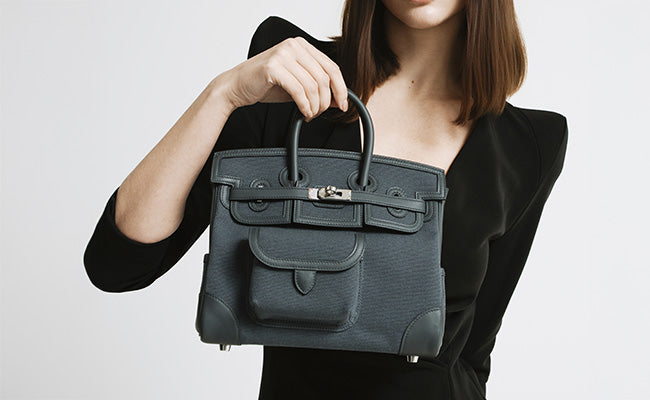
Lizard (Varanus) Essentials: Sizing Limits, Storage, and UV Risks
Check out our Hermès collection and Birkin bags!
Monitor lizards from the Varanus genus are nothing like your average pet gecko.
These clever, ancient-looking creatures demand a level of commitment and attention that’s honestly a bit more like owning a high-end sports car or maybe a living, breathing designer bag that could outlive your dog. Some of these lizards can stick around for 25 years or more, so you’re in it for the long haul.
Adult Savannah monitors need a minimum enclosure of 8 feet by 4 feet by 4 feet. Pygmy monitors, being much smaller, obviously require less space, but don’t be fooled. They still need precise environmental controls.
You wouldn’t toss a luxury bag into a cardboard box, right? These lizards deserve custom-built homes that juggle temperature, humidity, and UV exposure just right.
Monitor lizard ownership isn’t for the faint of heart. Every detail matters. If you miss the mark, you’re risking your pet’s health and probably your wallet, too. Basking spots can hit 130°F, and you have to be careful with UV light. Too much or too little can spell trouble fast.
Key Takeaways
- Monitor lizards need large, custom enclosures with exacting climate control.
- UV lighting is crucial but must be dialed in to avoid burns or deficiency.
- These reptiles are smart and demanding. Expect to invest real time and resources.
Sizing Limits of Varanus Lizards
Monitor lizards run the gamut from 20-centimetre pygmy species weighing barely 10 grams to the monster Komodo dragon tipping the scales at over 100 kilograms. Most pet monitors land somewhere in the middle, but new owners often get caught off guard by how quickly these animals grow.
Savannah Monitor Size Expectations
The savannah monitor (Varanus exanthematicus) usually grows to 90 to 120 centimetres as an adult. Males can get bigger, sometimes up to 140 centimetres if you’ve got a giant on your hands.
Weight depends a lot on diet and care. Adults commonly weigh 2 to 4 kilograms, but if you overfeed, they’ll balloon up, and that’s a health risk you don’t want.
Growth Timeline:
- Hatchlings: 15 to 20 cm, 15 to 25 grams
- 6 months: 30 to 40 cm, 200 to 400 grams
- 1 year: 50 to 70 cm, 800 to 1,200 grams
- 2 to 3 years: Adult size
Growth Rate and Adult Size
Monitor lizards grow like weeds their first two years. People buy “cute” juveniles and then, suddenly, they’ve got a two-foot lizard barreling around the living room.
Growth speed depends on temperature, diet, and husbandry. If you nail the conditions, they’ll grow faster. Bad care can stunt them for life.
Most Varanus species hit sexual maturity at 2 to 4 years. After that, growth slows down, but some keep growing (albeit slowly) until they’re 5 to 7 years old.
What affects size?
- Genetics: Wild-caught often grow bigger.
- Diet: Quality protein is key.
- Temperature: Good basking spots mean better growth.
- Space: More room equals more natural movement.
Size Differences Across Species
Varanus is a wild genus, size-wise. Knowing your species helps you plan.
Common Pet Species Sizes:
- Savannah monitor: 90 to 120 cm, 2 to 4 kg
- Nile monitor: 120 to 200 cm, 5 to 15 kg
- Water monitor: 120 to 180 cm, 4 to 12 kg
- Ackie monitor: 60 to 70 cm, 200 to 400 grams
Nile monitors are among the largest commonly kept. They can hit 2 metres and 10 kilograms, which is a lot of lizard. Ackies are smaller and more manageable, but even they need more room than most people expect.
Size Considerations for Luxury Enclosures
If you want to do it right, plan for the adult size from the start. Juvenile measurements won’t cut it.
Minimum Enclosure Dimensions:
- Length: 2x adult total length
- Width: 1x adult total length
- Height: 1.5x adult total length (for semi-arboreal species)
Honestly, bigger is always better. Think of it as the difference between a cramped studio and a roomy penthouse.
Custom enclosures should let your lizard climb, dig, and thermoregulate. Using real stone and hardwood looks incredible and actually helps with function.
If you go big, get a pro to build it. Large monitors are strong and can wreck flimsy setups in no time.
Optimal Enclosure and Storage Requirements
Building a monitor lizard home is like picking out a luxury bag: size, materials, and craftsmanship all matter. You need to get temperature, substrate, and layout just right if you want your lizard to thrive.
Minimum and Ideal Enclosure Sizes
Don’t cut corners here. A 4x2x2 foot enclosure might do for a juvenile, but that’s just a starting point.
Adult savannah monitors really need at least 8x4x4 feet. Bigger species? You’re looking at something closer to a whole room.
Height is a big deal for arboreal types. If you can swing 6 to 8 feet of vertical space, do it.
Glass terrariums look great, but wooden vivariums with waterproof linings are warmer and easier to customize. Make sure you’ve got strong locks. These lizards are escape artists.
Luxury Substrate Choices
Cypress mulch is top-tier for humidity and digging. Mixing in organic topsoil gives it better texture and water retention.
Coconut coir is easy to work with and holds moisture well. For desert species, we add sand to mimic their natural terrain.
Skip pine and cedar shavings. They’re toxic. Aspen shavings are okay for dry-loving species but don’t hold humidity like the premium stuff.
Depth matters. Give them at least 6 to 8 inches for burrowing. It’s not just for fun. They use it to regulate temperature and behave naturally.
Good substrate isn’t cheap. Plan to swap it out every 2 to 3 months, and spot-clean every day.
Sophisticated Hideouts and Enrichment
Monitors want places to hide on both warm and cool sides. Hollow logs, caves, and rock piles all work.
Climbing structures make a huge difference. Sturdy driftwood, cork bark, and rocks give them exercise and help use that vertical space.
Semi-aquatic species love water features. A big, filtered basin lets them soak and helps keep humidity up.
Live plants are a nice touch. Pothos and snake plants are tough enough, and they look a lot better than plastic.
Rotate enrichment stuff every month or so. If you mix it up, your lizard will stay curious and active.
Humidity and Temperature Precision
You need to be exact with temps. Basking spots should hit 100 to 130°F (check your species), cool sides around 75 to 85°F.
Savannah monitors like 40 to 60% humidity. Water monitors want 70 to 80%. Invest in good hygrometers and thermostats. Cheap gear will cost you more at the vet.
Ceramic heat emitters and halogen lamps are reliable. Skip heat rocks. They’re a burn risk. Use several thermometers to keep tabs on different spots.
UVB lighting is a must for calcium metabolism. Change bulbs every six months even if they still look bright. UV output drops off way before the bulb dies.
Automated misting makes life easier. Big water bowls help with humidity and give your lizard a drink.
The Essential Role of UV Lighting
Monitor lizards need UVB light to make vitamin D3 and avoid metabolic bone disease. The right bulb and setup can make all the difference.
Importance of UVB for Monitor Health
UVB isn’t optional. Without it, these reptiles can’t make vitamin D3, and their bodies can’t absorb calcium, no matter how much you feed them.
Metabolic bone disease is the big risk. If your lizard doesn’t get enough UVB, you’ll see:
- Soft, brittle bones
- Deformed limbs and spines
- Muscle weakness, tremors
- Sometimes even organ failure
In the wild, they bask for hours under intense sunlight. We have to mimic that in captivity.
Good UVB also helps their immune system. There’s real evidence that monitors with proper lighting get sick less often and heal faster.
Types of UVB Bulbs for Varanus
A few options out there for UVB bulbs:
Mercury vapour bulbs give you UVB and heat together, great for big monitors that want hot basking areas.
T8 fluorescent tubes spread UVB evenly, but your lizard needs to be within 30 centimetres to benefit.
T5 fluorescent bulbs are stronger, so you can mount them farther away and still get good UVB.
| Bulb Type | UVB Output | Best Distance | Lifespan |
|---|---|---|---|
| Mercury Vapour | High | 45 to 60cm | 12 months |
| T5 Fluorescent | Medium-High | 30 to 45cm | 12 months |
| T8 Fluorescent | Medium | 15 to 30cm | 6 to 8 months |
Compact fluorescents are spotty in coverage. Better to avoid them for monitors.
Setting Up a Sunbeam Experience
Getting the basking spot right takes some thought. Put the UVB source right above where your lizard likes to bask.
Distance is critical. Too far and it’s useless, too close and you risk burns or eye damage.
Use a UV meter to check levels at the basking spot. Most monitors want a UV Index of 4 to 7, depending on where their species comes from.
Change bulbs every 6 to 12 months, even if they still look bright. UVB drops off way before they burn out.
Set your lights for 12 to 14 hours a day in summer, 10 to 12 in winter.
Adding a reflector boosts efficiency and directs more UVB where it’s needed. It’s a simple upgrade that can make a big difference.
UV Risks and Overexposure Concerns
You need UV for healthy lizards, but too much is dangerous. Overdoing it can cause burns, eye issues, and even metabolic bone disease if the lighting is set up wrong. Knowing what to watch for can save your lizard a lot of grief.
Common UVB-Related Health Problems
Metabolic bone disease is the big one if you mess up UVB. Without enough, monitors can’t process calcium, which leads to weak bones, deformities, and tremors. Severe cases show jaw deformities and fractures, sometimes from just being handled.
Sunburn is another risk, especially if you put a mercury vapour lamp too close. Savannah monitors can take more sun, but forest species burn quickly.
Look for red or blackened skin, blisters, or peeling. Bad burns can get infected and need a vet.
Eye damage happens when lamps are too strong or not shielded properly. Signs include cloudy eyes, squinting, or just staying away from the light.
Signs of Overexposure in Savvy Monitors
Monitors act differently when they’re getting too much UV. If your lizard suddenly hides all the time instead of basking, that’s a red flag.
Physical symptoms: Watch for darkening or reddening of the skin, especially on the head and back. Blisters mean you need to move the lamp ASAP.
If your monitor stops eating or seems sluggish, check your lighting. Savannah monitors, in particular, usually love their food. If they stop, something’s up.
Keep an eye on basking habits. Healthy monitors go back and forth between basking and hiding. If yours is always hiding, double-check your setup.
Eye problems, like squinting, discharge, or keeping eyes closed, are signs your UVB is too strong. Don’t ignore it; eye damage can be permanent.
Preventing UV Damage in Your Collection
Choosing the right lamp usually keeps UV problems at bay. We need to match lamp output to what each species actually needs. Forest types want much less UV than sun-loving desert species.
Ferguson zones help make sense of it all:
- Zone 1: Shade species (0.7 to 1.0 UV index)
- Zone 2: Partial sun species (1.0 to 1.4 UV index)
- Zone 3: Open basking species (1.4 to 3.0 UV index)
- Zone 4: Desert species (3.0+ UV index)
Managing distance is key. We set lamps at the distances the manufacturer recommends and make sure there are warm and cool spots, plus places to hide.
Timers keep photoperiods consistent. Most monitors do well with 10 to 12 hours of light, then total darkness for the rest.
We use UV meters to track lamp strength. Mercury vapour bulbs drop off after 6 to 12 months; T5 tubes last about 12 to 18 months before they need swapping.
During quarantine, UV exposure needs extra attention. Stressed animals get less UV at first, and we slowly increase it as they settle in.
Curating a Gourmet Diet for Varanus
If you want to spoil your monitor lizard, you’ve got to think like a chef. It’s about great protein, top-notch supplements, and storing everything with care. That’s how you turn basic feeding into something special.
Insects: Crickets and Roaches
Honestly, you can’t talk about monitor cuisine without starting with insects, the caviar of the reptile world. Crickets are the staple, but not just any. Banded crickets pack more nutrition than the common house variety. We buy from suppliers who care about quality.
Dubia roaches are the gold standard. Cleaner than crickets, almost no smell, and loaded with protein. They’re basically the wagyu beef of bugs.
Gut-loading is a game changer. We feed our insects high-end veggies, grains, and gut-load formulas for a day or two before offering them to the monitors.
For savannah monitors and similar species, we mix things up: grasshoppers in spring, hornworms for summer, superworms in winter. Keeps things interesting.
Size really does matter. Insects should never be wider than the space between your monitor’s eyes. We keep a few sizes around for when they hit those growth spurts.
Occasional Rodents and Dietary Treats
Insects are the daily staple, but rodents are for special occasions. We treat frozen-thawed mice and rats like a fine wine. Quality is non-negotiable.
Pre-killed rodents are safer, no parasites, same nutrition. We only buy from suppliers who freeze them right after humane dispatch.
Young monitors get pinkies about once a month. Adults, maybe a full mouse every few months, but that’s it.
Quail eggs are a fantastic treat. We offer them raw, shell and all. Watching a monitor break into an egg is always a highlight.
For water monitors, fish adds variety. Whole feeder fish are best. Just skip the goldfish because of thiaminase.
Rodents should be no more than 20% of the total diet. We weigh our monitors monthly to keep portions in check.
Wild-caught prey? Just not worth the risk. Parasites and pesticides are real dangers.
Supplements and Vitamin Glam
Even with a great diet, supplements matter. We handle vitamins the way some people handle skincare. Good ingredients, right timing.
We dust insects with calcium powder twice a week. Pharma-grade only, no weird fillers.
Vitamin D3 is crucial if UVB isn’t perfect. We like combined calcium-D3 powders for simplicity.
Multivitamins? Once a week, max. Too much causes more trouble than too little. We switch brands now and then to avoid build-up.
Probiotics help with digestion, especially during stress or when changing foods. Reptile-specific ones seem to work best.
Technique counts. We dust lightly so the powder sticks but doesn’t turn insects into chalky blobs. A gentle shake in a container usually does the trick.
Monitors tell you how things are going. Good appetite and steady growth mean the supplements are working.
Food Storage for the Luxe Keeper
Storage makes a difference. We organize our reptile pantry almost like a wine cellar.
Frozen rodents need steady, cold temps. A dedicated chest freezer works way better than sharing space with human food.
Live insects need their own climate control. Separate containers for crickets and roaches, with proper airflow and warmth.
Gut-load ingredients go in airtight containers. Everything gets a label with the purchase date, and we rotate stock to avoid waste.
Supplements lose their punch over time. We keep calcium powder cool and dry, and toss open containers after six months.
Feeding gear matters too. Dedicated tongs, bowls, and measuring spoons help keep things clean between species.
A little organization goes a long way. We keep charts of who ate what and when they last got supplements.
Care Must-Haves for Experienced Keepers
If you’ve kept reptiles for a while, you know the details matter: tight environmental control, smart handling, and spotting health problems early. Savannah monitors, especially, need high standards. Proper heat gradients and real enrichment, not just the basics.
Savannah Monitor Care Details
Adult savannah monitors need custom enclosures, at least 240cm x 120cm x 120cm. Off-the-shelf tanks just don’t cut it.
Temperature gradients are non-negotiable. Basking spots at 50 to 60°C, cool areas at 24 to 28°C. We use multiple heat sources, ceramic emitters plus strong basking bulbs.
Substrate matters a lot. We go for at least 30cm of diggable mix: soil, sand, or coconut coir. Savannahs love to dig, and cheap substrate just won’t do.
UVB lighting needs to be strong, 10 to 12% output, bulbs replaced every six months. There’s no wiggle room here; metabolic bone disease creeps up fast if you slack off.
Humidity should stay between 40 to 60%. Big water dishes and a bit of misting usually do the trick.
Diet is mostly Dubia roaches, crickets, and locusts, with the odd quail egg. We avoid mealworms and keep rodents to a minimum. Too many lead to obesity, which is a silent killer in captivity.
Handling Like a Pro
Young monitors need regular, gentle handling to build trust. We start early and keep sessions consistent.
Always support their whole body. Don’t grab tails or limbs. These guys are strong and can lash out if they feel threatened.
Move slowly. Quick movements trigger defensive reactions, even in calm individuals.
Watch for stress: gaping, tail thrashing, defensive stances. If you see these, it’s time to back off.
Adults can get up to 5 to 8kg and have real strength. Even the friendliest monitor can scratch or nip if startled.
Spotting Health Issues Early
Metabolic bone disease shows up as lethargy, soft bones, and trouble moving. It’s usually from poor UVB or low calcium, totally preventable.
Respiratory infections cause wheezing, runny noses, and open-mouth breathing. Usually, it’s humidity or temperature issues.
Weighing monitors helps keep obesity in check. We do it monthly and adjust food as needed.
Parasites pop up more in wild-caught monitors. If you see diarrhea, low energy, or weight loss, get a vet to check for internal parasites.
Regular vet visits with a reptile specialist catch problems early. Annual exams and parasite checks keep collections healthy.
Frequently Asked Questions
Here are some real-world questions about keeping Varanus monitors when you’re used to the finer things. We cover everything from space needs to UV setups and humidity for your high-end collection.
What's the maximum size a Varanus can grow to, and how does it compare to the space in my handbag collection?
Asian Water Monitors can reach 6 to 10 feet and tip the scales at 70 kilograms. That’s about the size of a small luxury sofa, definitely not handbag material.
Savannah Monitors are more practical at 3.5 to 4 feet. It’s like comparing a clutch to a weekend bag.
The biggest species need at least a 16 by 10 foot enclosure. Even a spacious walk-in closet for handbags probably won’t cut it.
Is my deluxe walk-in closet a suitable habitat for my monitor lizard or am I risking a fashion faux pas?
Your fancy closet just doesn’t have the airflow, temperature control, or drainage a monitor needs. Converting spaces is one thing, but repurposing storage isn’t the answer.
Adult monitors need custom enclosures with places to swim, bask, and climb. Typical closet climate control can’t handle the humidity levels. Think 60 to 80%.
It’s better to dedicate a room or build something custom. Like commissioning a bespoke suit, it takes planning and investment.
What's the real deal on UVB lighting for my scaly friend, necessary luxe or overrated accessory?
UVB lighting isn’t just for show. It’s essential. Monitors need it to make vitamin D3 and process calcium.
Good UVB fixtures cost a few hundred dollars and need swapping every 6 to 12 months. Think of it like your skincare routine, consistent and not up for debate.
Mercury vapour bulbs and T5 tubes are the best bet. Cheap options are like knockoff designer bags. They’ll let you down.
How often should I be revisiting my lizard's living quarters to ensure it's living its best life?
Daily checks are a must: temperature, humidity, and cleanliness. Morning and evening, just like checking on your favorite shoes.
Change the water every few days, or sooner if it gets dirty. Substrate cleaning depends on what you use, but weekly is a good rule.
Deep cleans and full maintenance should happen monthly. It’s like rotating your wardrobe, thorough and necessary.
In terms of diet, what gourmet treats should I be serving to keep my Varanus in vogue?
Adults do best on whole prey like rats, rabbits, and fish, fresh and high-quality, not processed.
Juveniles get smaller fare: mice, chicks, insects. Mix it up; variety keeps them healthy.
Feeding schedules depend on age and species. Adults eat every 3 to 7 days, while growing juveniles need food daily.
Could my lizard's need for humidity clash with the ideal conditions for storing my collection of silk scarves?
Yeah, they definitely can. Monitors thrive at 60 to 80% humidity, way too damp for delicate fabrics or leather. Luxury scarves, for example, really need things drier and steady, closer to 45 to 55% humidity.
Too much moisture? That’s just asking for mold and ruined fabric. I’d honestly keep your scarves and your reptile in totally separate, climate-controlled spaces.
Maybe look into separate HVAC setups, or at least pick different rooms. Those investment pieces? They deserve just as much thought as your lizard’s habitat, if not more.




